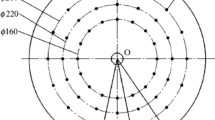Abstract
Laser shock tensioning process for circular saw blade was proposed in this paper. For exploring the stress formation mechanism of circular saw blade after laser shock tensioning process, theoretical model was built based on finite element method, some reasonable simplifications and assumptions. By comparing theoretical and measured results, the theoretical model was proved to be correct and laser shock tensioning process was proved to be feasible. The effects of spot diameter, impact zone radius, and number of circumferential impact zone on tensioning stress field were studied. Simulation results show that reducing spot diameter and extending impact zone are two effective ways for increasing the tangential tensile tensioning stress in the edge of circular saw blade and enhancing tensioning effect. An optimized scheme for laser shock tensioning process can be obtained by the theoretical model.
Similar content being viewed by others
References
Chang WT, Chen LC (2016) Design and experimental evaluation of a circular saw blade with self-clamped cutting inserts. Int J Adv Manuf Technol 83(1):1–15. https://doi.org/10.1007/s00170-015-7563-7
Turchetta S (2009) Cutting force on a diamond grit in stone machining. Int J Adv Manuf Technol 44(9):854–861. https://doi.org/10.1007/s00170-008-1905-7
Li S, Wang C, Zheng L, Wang Y, Xu X, Feng D (2016) Dynamic stability of cemented carbide circular saw blades for woodcutting. J Mater Process Tech 238:108–123. https://doi.org/10.1016/j.jmatprotec.2016.07.018
Li B, Zhang ZK, Li WG, Peng XR (2015) A numerical simulation on multi-spot pressure tensioning process of circular saw blade. J Wood Sci 61(6):578–585. https://doi.org/10.1007/s10086-015-1508-5
Szymani R, Mote CD (1979) Theoretical and experimental analysis of circular saw tensioning. Wood Sci Technol 13(3):211–237. https://doi.org/10.1007/BF00350225
Szymani R, Mote CD (1974) A review of residual stresses and tensioning in circular saws. Wood Sci Technol 8(2):148–161. https://doi.org/10.1007/BF00351369
Nicoletti N, Fendeleur D, Nilly L, Renner M (1996) Using finite elements to model circular saw roll tensioning. Eur J Wood Wood Prod 54(2):99–104. https://doi.org/10.1007/s001070050146
Heisel U, Stehle T, Ghassemi H (2014) A simulation model for analysis of roll tensioning of circular saw blade. Adv Mater Res 1018:57–66. https://doi.org/10.4028/www.scientific.net/AMR.1018.57
Li B, Zhang ZK, Li WG, Peng XR (2015) Effect of yield strength of a circular saw blade on the multi-spot pressure tensioning process. BioResources 10(4):7501–7510. https://doi.org/10.15376/biores.10.4.7501-7510
Li B, Zhang ZK, Li WG, Peng XR (2015) Model for tangential tensioning stress in the edge of circular saw blades tensioned by multi-spot pressure. BioResources 10(2):3798–3810. https://doi.org/10.15376/biores.10.2.3798-3810
Umetsu J, Noguchi M, Wada K, Fujii Y (1989) Confirmation of φ splitting in the distribution of residual stress in tensioning circular saws (in Japanese). Mokuzai Gakkaishi 35(9):856–858
Umetsu J, Noguchi M, Matsumoto I (1994) Measuring residual stresses in tensioned circular saws using X-rays (in Japanese). Mokuzai Gakkaishi 40:268–273
Dai F, Zhou J, Lu J, Luo X (2016) A technique to decrease surface roughness in overlapping laser shock peening. Appl Surf Sci 370:501–507. https://doi.org/10.1016/j.apsusc.2016.02.138
Ren X, Zhou W, Liu F, Ren Y, Yuan S, Ren N, Xu S, Yang T (2016) Microstructure evolution and grain refinement of Ti-6Al-4V alloy by laser shock processing. Appl Surf Sci 363:44–49. https://doi.org/10.1016/j.apsusc.2015.11.192
Sibalija TV, Petronic SZ, Majstorovic VD, Milosavljevic A (2014) Modelling and optimisation of laser shock peening using an integrated simulated annealing-based method. Int J Adv Manuf Technol 73(5–8):1141–1158. https://doi.org/10.1007/s00170-014-5917-1
Irizalp SG, Saklakoglu N, Yilbas BS (2014) Characterization of microplastic deformation produced in 6061-T6 by using laser shock processing. Int J Adv Manuf Technol 71(1–4):109–115. https://doi.org/10.1007/s00170-013-5481-0
Yang C, Ye Z, Lu J, Jiang Y (2011) Laser shock forming of SUS304 stainless steel sheet with elliptical spot. Int J Adv Manuf Technol 56(9–12):987–993. https://doi.org/10.1007/s00170-011-3232-7
Yilbas BS, Mansoor SB, Arif AFM (2009) Laser shock processing: modeling of evaporation and pressure field developed in the laser-produced cavity. Int J Adv Manuf Technol 42(3–4):250–262. https://doi.org/10.1007/s00170-008-1601-7
Salimianrizi A, Foroozmehr E, Badrossamay M, Farrokhpour H (2016) Effect of laser shock peening on surface properties and residual stress of Al6061-T6. Opt Laser Eng 77:112–117. https://doi.org/10.1016/j.optlaseng.2015.08.001
Fu J, Zhu Y, Zheng C, Liu R, Ji Z (2016) Effect of laser shock peening on the compressive deformation and plastic behavior of Zr-based bulk metallic glass. Opt Laser Eng 86:53–61. https://doi.org/10.1016/j.optlaseng.2016.05.014
Ding K, Ye L (2006) Simulation of multiple laser shock peening of a 35CD4 steel alloy. J Mater Process Tech 178(1–3):162–169. https://doi.org/10.1016/j.jmatprotec.2006.03.170
Peyre P, Fabbro R, Merrien P, Lieurade HP (1996) Laser shock processing of aluminium alloys, application to high cycle fatigue behaviour. Mater Sci Eng A 210(1-2):102–113. https://doi.org/10.1016/0921-5093(95)10084-9
Zhou N, Qiao DJ (2002) Dynamics of materials irradiated by pulsed beams. National Defense Industry Press, Beijing
Acknowledgments
We gratefully acknowledge the financial support of National Natural Science Foundation of China (No.31600458) and Fundamental Research Funds for the Central Non-profit Research Institution of CAF (No. CAFYBB2017SY039).
Author information
Authors and Affiliations
Corresponding author
Rights and permissions
About this article
Cite this article
Li, B., Zhang, Z. Theoretical modeling and analysis for tensioning stress formation mechanism of laser shock tensioning process. Int J Adv Manuf Technol 96, 247–256 (2018). https://doi.org/10.1007/s00170-018-1607-8
Received:
Accepted:
Published:
Issue Date:
DOI: https://doi.org/10.1007/s00170-018-1607-8




